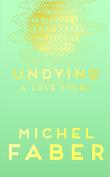AustLit
Latest Issues
AbstractHistoryArchive Description
'A heartbreaking chronicle of losing the love of your life by Michel Faber, the award-winning author of The Book of Strange New Things.
'How can you say goodbye to the love of your life?
'In Undying Michel Faber honours the memory of his wife, who died after a six-year battle with cancer. Bright, tragic, candid and true, these poems are an exceptional chronicle of what it means to find the love of your life. And what it is like to have to say goodbye.
'All I can do, in what remains of my brief time, is mention, to whoever cares to listen, that a woman once existed, who was kind and beautiful and brave, and I will not forget how the world was altered, beyond recognition, when we met.' (Publication summary)
Publication Details of Only Known VersionEarliest 2 Known Versions of
Works about this Work
-
Veiling and Unveiling : Ill, Dying, and Dead Bodies in Contemporary Elegies
2022
single work
criticism
— Appears in: Orbis Litterarum , February vol. 77 no. 1 2022; (p. 70-81)'According to Sandra Gilbert, one of the contemporary elegy’s most striking features is its obsession with the actual scene of dying and the actual body of the dead one. Gilbert interprets this obsession as an exponent of the modern elegy’s typical ambition of breaking the tenacious taboo on dying and grieving—an ambition that had been demonstrated earlier by Jahan Ramazani’s pioneering Poetry of Mourning. By explicitly showing ill, dying, or dead bodies, Gilbert contends, recent elegies confront us with what modern culture prefers to hide.
'Concentrating on representations of the body in Intensive Care (2010) by the Dutch poet Vrouwkje Tuinman and Undying (2016) by the Scottish-Dutch writer Michel Faber, the present article seeks to complicate dominant interpretations of the function of the corpse in recent poetry. Although Tuinman and Faber do show dying and dead bodies with meticulous attention, they also subtly open up reflections on the mimesis of illness and death. By alternately watching and veiling the body, approaching it as an abject object and an aesthetic artifact, Tuinman and Faber both challenge and confirm the problematic and ambiguous status of the corpse in the contemporary West.' (Publication abstract)
-
Blunt Response to an Unexpected Death
2016
single work
review
— Appears in: The Saturday Age , 8-9 October 2016; (p. 20) The Sydney Morning Herald , 8-9 October 2016; (p. 26)
— Review of Undying : A Love Story 2016 selected work novel
-
Blunt Response to an Unexpected Death
2016
single work
review
— Appears in: The Saturday Age , 8-9 October 2016; (p. 20) The Sydney Morning Herald , 8-9 October 2016; (p. 26)
— Review of Undying : A Love Story 2016 selected work novel -
Veiling and Unveiling : Ill, Dying, and Dead Bodies in Contemporary Elegies
2022
single work
criticism
— Appears in: Orbis Litterarum , February vol. 77 no. 1 2022; (p. 70-81)'According to Sandra Gilbert, one of the contemporary elegy’s most striking features is its obsession with the actual scene of dying and the actual body of the dead one. Gilbert interprets this obsession as an exponent of the modern elegy’s typical ambition of breaking the tenacious taboo on dying and grieving—an ambition that had been demonstrated earlier by Jahan Ramazani’s pioneering Poetry of Mourning. By explicitly showing ill, dying, or dead bodies, Gilbert contends, recent elegies confront us with what modern culture prefers to hide.
'Concentrating on representations of the body in Intensive Care (2010) by the Dutch poet Vrouwkje Tuinman and Undying (2016) by the Scottish-Dutch writer Michel Faber, the present article seeks to complicate dominant interpretations of the function of the corpse in recent poetry. Although Tuinman and Faber do show dying and dead bodies with meticulous attention, they also subtly open up reflections on the mimesis of illness and death. By alternately watching and veiling the body, approaching it as an abject object and an aesthetic artifact, Tuinman and Faber both challenge and confirm the problematic and ambiguous status of the corpse in the contemporary West.' (Publication abstract)




